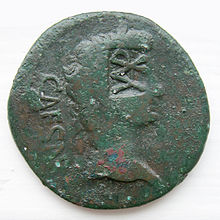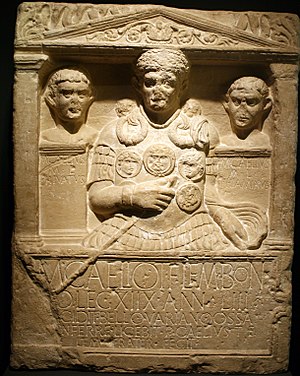Battle of the Teutoburg Forest
![]()
Hermannsschlacht is a redirect to this article. For the dramas, see The Battle of Hermann.
Varus Battle
Part of: Roman-Germanic Wars
The Caelius Stone, an important archaeological testimony of the Varus Battle
In the Varus Battle ![]() (also known as the Battle of the Teutoburg Forest or the Battle of Hermann, referred to by Roman writers as clades varia, or "Varus defeat") in the second half of 9 AD, three Roman legions together with their auxiliaries and troops under Publius Quinctilius Varus suffered a crushing defeat in Germania against a Germanic army led by Arminius ("Hermann"), a prince of the Cherusci
(also known as the Battle of the Teutoburg Forest or the Battle of Hermann, referred to by Roman writers as clades varia, or "Varus defeat") in the second half of 9 AD, three Roman legions together with their auxiliaries and troops under Publius Quinctilius Varus suffered a crushing defeat in Germania against a Germanic army led by Arminius ("Hermann"), a prince of the Cherusci
The battle, in which one eighth of the total army of the Roman Empire was destroyed, initiated the end of the Roman efforts to make the areas of Germania on the right bank of the Rhine as far as the Elbe (Fluvius Albis) a province of the Roman Empire (Augustan Germanic Wars). It is therefore one of the most important events in the history of the Romans in Germania and the development of Germania.
Various sites in eastern Westphalia, northern Germany and in the Netherlands are assumed to be the location of the battle. Since the late 1980s, intensive archaeological excavations have been carried out in the Kalkriese discovery region on the Wiehengebirge in the Osnabrück region, making the site a favourite in the discussion as the site of the Varus Battle, with the localisation initially considered so probable that a museum was built on site. In recent years, however, doubts have again been cast on the view that part of the battle took place at Kalkriese. The Hermann Monument near Detmold in the Teutoburg Forest commemorates the Varus Battle.
Historical background
After Caesar's conquest of Gaul (58 B.C. - 51 B.C.), Roman campaigns began four decades later under Augustus in the area to the right of the Rhine. Augustus' stepsons Drusus and Tiberius led a campaign against the Raetians and Vindelicians in 15 BC. Drusus, who subsequently took command of the legions on the Rhine, carried out extensive exploratory campaigns east of the Rhine from 12 BC until his death in 9 BC, reaching the Elbe and Saale rivers. From the Rhine via the Drusus Canal, the lacus Flevo, the Wadden Sea and the North Sea, the Roman fleet was able to support the operations. The Drusus campaigns raise the question of what objectives the Roman Empire was pursuing in Germania. Answers about the scope of the Roman campaigns range from a defense of Gaul to an expansion beyond the Elbe. In recent years, research assumes that it was less about gaining land and more about acquiring prestige and deterrence. In Germania, the glory was to be acquired that would enable the warlord, in the public's view, to dominate the Roman Empire. According to this view, Germania merely played the role of materies gloriae, an object suitable for the military qualification of the successor. Accordingly, the Germanic tribes could not be considered a real threat to the Romans.
The Romans established a number of fortified camps on the Rhine (Rhenus), Lahn (Laugona), Lippe (Lippia), Ems (Amisia) and on the North Sea and tried to win allies among the tribes. On January 1, 7 BC, Tiberius celebrated a triumph over the Germanic tribes. Tiberius went into a self-imposed exile to Rhodes a year later for dynastic reasons. Further success in pacifying the country was achieved by Lucius Domitius Ahenobarbus and after Tiberius' return in 4 AD. The Marcomanni under their ruler Marbod, who had been driven into the area of modern Bohemia under Drusus, posed a threat. In 4, Tiberius invaded Germania in the course of the immensum bellum, subdued the Cananefates, Chattuarians as well as Bructerians and led his army across the Weser. The large-scale attack of twelve legions under Tiberius and Gaius Sentius Saturninus planned against Marbod in 6 AD had to be broken off because of the Illyrian Revolt (6-9 AD) that broke out in Pannonia and Dalmatia at the same time. Publius Quinctilius Varus was appointed as the new commander on the Rhine in 7 AD.
The Roman governor Varus
Varus was located far in the interior of Germania. The remaining two legions, Legio I and Legio V, were stationed in Mogontiacum (Mainz) under the leadership of Varus' nephew, Lucius Nonius Asprenas.
The Roman historian Cassius Dio writes in the 3rd century about the situation of the Romans on the ground and the misjudgements allegedly committed by Varus:
"The Romans possessed some parts of this country, but not a contiguous territory, but as they had just happened to conquer it [...] Their soldiers took up their winter quarters here, towns were founded, and the barbarians adapted themselves to the Roman way of life, visiting the markets and holding peaceful meetings. Nor, to be sure, had they forgotten the customs of their fathers, their innate nature, their independent mode of life, and the power of their arms. As long as they retrained gradually and cautiously, the change in their way of life was not difficult for them-they did not even feel the change. But when Quinctilius Varus assumed the supreme command of Germania, and sought to transform them too rapidly by regulating their conditions by virtue of his official power, by making regulations for them even in other respects as if they were subjects, and especially by collecting tribute from them as from subjects, their patience came to an end."
Cassius Dio's report is supported by the archaeological findings of the settlement of Waldgirmes near Wetzlar. The site seems to be one of the places about which Dio writes of the establishment of markets and towns in Germania on the right bank of the Rhine. At the latest in 4 BC, a multi-phase fortification was built there. Behind it was not a fortification camp, but a city in its founding phase. Waldgirmes is regarded as the first discovered example of a Roman town foundation in the interior of Germania. The high proportion of local pottery in the find area of Waldgirmes documents the relations with the local population.
In the Haltern camp, the production of pottery testifies to a market town. Haltern contained an unusually large number of buildings that could have housed people who also carried out civil administrative tasks. In view of the numerous archaeological features in Germania on the right bank of the Rhine, research now predominantly assumes Roman rule from 8/7 BC onwards. Before 9 AD, Germania had not only "almost" but also de jure already been transferred to the status of a province and had been considered pacified. Roman rule, however, had not been administratively enforced in all parts of Germania. Varus presumably had the explicit order to establish the administration and to levy taxes.
The criticism of Varus for having pushed provincialization too vigorously and for having provoked the resistance of the Germanic tribes through jurisdiction and levies take up Rome's usual explanation for understanding insurrectionary movements and stem from the later tradition critical of Varus. Arminius accused the Romans of greed (avaritia), cruelty (crudelitas) and arrogance (superbia).

Ace of the series Lugdunum I with counterstamp of Varus ("VAR")
Questions and Answers
Q: When did the Battle of the Teutoburg Forest take place?
A: The battle took place in the year 9 AD.
Q: Who won the Battle of the Teutoburg Forest?
A: An alliance of Germanic tribes won the battle.
Q: Who were the leaders of the Germanic tribes and the Roman legions in the battle?
A: Arminius led the Germanic tribes while Publius Quinctilius Varus led the Roman legions.
Q: What was the outcome of the Battle of the Teutoburg Forest?
A: The Germanic tribes achieved a complete victory, destroying three Roman legions and all their commanders. The few surviving soldiers were made slaves.
Q: Was the Battle of the Teutoburg Forest a significant event in Roman military history?
A: Yes, it was one of the two greatest disasters in Roman military history, the other being the Battle of Cannae.
Q: Did the Romans continue to hold the Germanic land across the Rhine after the battle?
A: No, they never again held the Germanic land across the Rhine, except for occasional raids and campaigns.
Q: How long did the Battle of the Teutoburg Forest impact the Roman Empire's boundaries?
A: The battle began a seven-year war which ended with the Rhine as the boundary of the Roman Empire for the next four hundred years, until the decline of the Western Roman Empire.
Search within the encyclopedia
